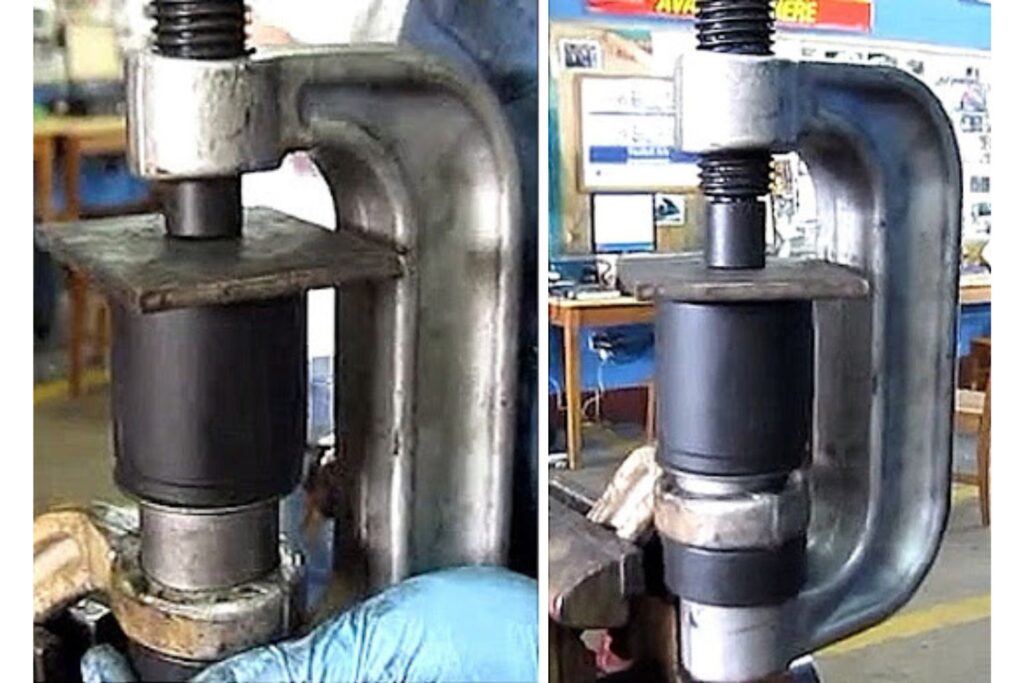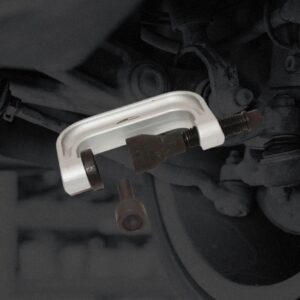Suspension bushings are relatively small but essential components in your vehicle’s suspension system. They slot into various other suspension parts, such as the control arms, and act as vibration isolators that minimize wear by preventing metal-to-metal contact. Because they take the brunt of the friction in these areas, suspension bushings need to be changed when they wear out. You might’ve heard that it’s best to use a suspension bush press to remove your vehicle’s worn suspension bushings. But what is this tool exactly, and are there alternatives you can use instead?
What Is the Best Suspension Bush Press Tool?
Most professional mechanics choose to use a hydraulic shop press as a suspension bush removal tool. Hydraulic shop presses pop the bushing straight out of their slot using hydraulic force. These presses are also able to slot new bushings into place, making them the ideal tool for removing and installing suspension bushings. Unfortunately, hydraulic shop presses aren’t readily available for most DIYers. They’re expensive, and it’s costly to maintain them, so if you don’t have one in your garage, it might be tempting to look for alternatives.
How To Remove Bushings Without a Press
Removing a vehicle’s suspension parts to access its bushings is already a big job for only the most experienced DIYers. Using tools unsuited for removing those bushings afterwards can be risky for both the vehicle’s parts and your general wellbeing. While there are ways to remove suspension bushings without a shop press, we don’t recommend using these methods unless you know what you’re doing.
Blowtorch
One of the most common ways to remove suspension bushings without a press is to use a blowtorch. This is best for rubber suspension bushings that melt under extreme heat. Don’t use a blowtorch on fluid-filled bushings. It’s dangerous.
Applying the heat straight to the bushing will likely damage the bushing and its outer metal shell. Instead, you should slowly heat up the bushing’s rubber by heating the housing around it. This will melt the rubber, leaving the outer metal shell intact so you can install a new rubber bushing. Once the heat has melted the rubber, you can carefully push the bushing out with a metal tool that fits in the bushing slot. You’ll need to clean out the rest of the melted rubber inside the slot before placing a new bushing.
Threaded Press

You can also try to use a threaded press to remove suspension bushings. These use mechanical force instead of hydraulic force to push the bushings out of their slots. Use a driver with the same diameter as the bushing’s outer shell. You might need a lot of force to push the bushing out, so use a wrench on the threaded press’s screw jack to produce rotational motion easier. This should push the bushing out of the suspension part once you apply some elbow grease.
Hammer and Socket
Finally, you can opt to use a hammer and socket to force the bushing out. Find a socket that will fit the bushing’s diameter and hold it over the bushing. Make sure it won’t catch on the sides of the bushing’s slot before hammering it down. The bushing should pop out after some strikes. This is the most difficult method for removing suspension bushings. You’re likely to also damage the bushing’s outer metal shell this way, making it unusable for any new bushing you plan to install. You can also try to use the socket alone to push the bushing’s rubber section out.
Whatever method you use to remove your vehicle’s suspension bushings, make sure to have a professional test your vehicle’s alignment afterwards. It’s risky to drive around if you’ve somehow damaged your vehicle’s suspension while removing the bushings.
Where to Get New Suspension Bushings for Your Ride
If you’ve done a couple of suspension repairs in your garage before, then you already know that the next step after prying out old bushings would be installing new ones. And where else could you find high-quality suspension bushings other than CarParts.com?
We have a great selection of suspension bushings that you can buy individually, as a set, or as part of a kit. All our suspension bushings are sourced from only the most trusted aftermarket brands today, so you can rest assured that our products will never let you down.
Start shopping by entering your vehicle’s year, make, and model into our vehicle selector. This will narrow down the catalog to compatible suspension bushings for your ride. For a more personalized shopping experience, use our search filters to further refine the results according to your preferred brand, price range, quantity, and more.
Shopping for OE-grade car parts has never been this easy with CarParts.com. Order now, and check out securely in a matter of minutes.
Thanks to our strategically located warehouses across the US, we can deliver the parts you need straight to your doorstep in as fast as two business days.
Shop now!
Any information provided on this Website is for informational purposes only and is not intended to replace consultation with a professional mechanic. The accuracy and timeliness of the information may change from the time of publication.




































